15 Facts You Didn't Know About P.F. Chang's
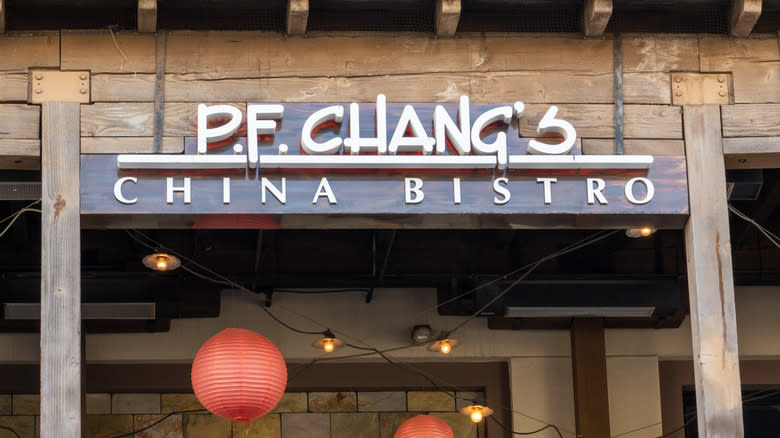
You can't mention Chinese food without bringing up P.F. Chang's China Bistro. It's been one of the world's most pivotal purveyors of Asian cuisine since 1993. Inspired by the woman credited with introducing authentic Northern Chinese food to The States, P.F. Chang's further elevated the Asian cuisine scene, helping to popularize wok-style cooking and lettuce wraps, amongst other things. Since then, success has made it a household name. There are now over 300 locations nationwide and internationally.
The most surprising part is that, in the beginning, it was never envisioned as a major chain. The impressive accomplishments extend beyond its massive worldwide footprint, too. It has a frozen food line, has ushered in other successful restaurants, and is often referenced in film and television. From the immersive dining aesthetic to its made-from-scratch approach, there are many reasons to fall in love with P.F. Chang's. Here are some interesting facts you probably didn't know about this Chinese cuisine pioneer.
Read more: Restaurant Foods That Always Taste Better Than What You Make At Home
P.F. Chang's Comes From A Rich History Of Chinese Restaurants
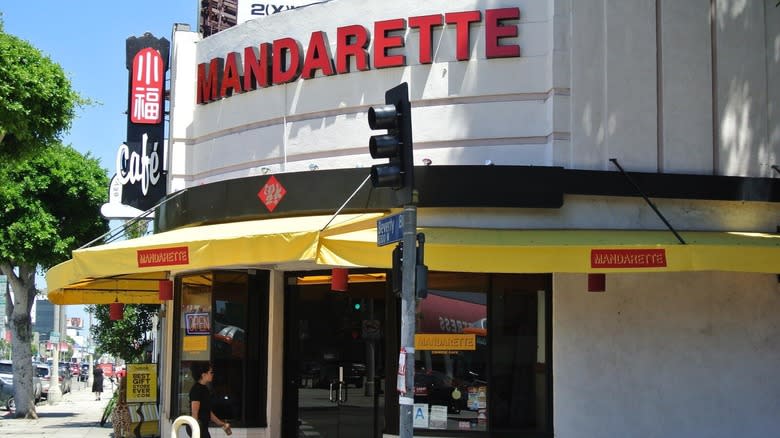
P.F. Chang's co-founder Philip Chiang gained firsthand experience working at his mother's restaurant, The Mandarin. Cecilia Chang's establishment was one of the Bay Area's first Chinese restaurants that served authentic Mandarin and Szechuan cuisine. Despite the restaurant's success, Philip chose to pursue art. He went on to graduate with a BFA from the ArtCenter College of Design, but quickly found himself in need of a reliable source of money, so subsequently decided to set aside his artistic pursuits and rejoin the family business.
Philip was put in charge of The Mandarin's Beverly Hills location while his mother was away in China. There he discovered a latent passion for the restaurant business, which led to the mother-and-son duo partnering on a new venture in 1984, which they called The Mandarette Chinese Café. She would later transfer ownership of the Beverly Hills Mandarin to Philip in 1989. He went from a reluctant restaurateur to owner of two locations. Then in 1991, they decided to sell The Mandarin, and -- around the early '90s -- The Mandarette as well.
During that period Philip befriended a customer named Paul Fleming, who happened to own the Los Angeles staple Ruth's Chris Steakhouse. When Fleming relocated to Arizona and found the Chinese food subpar, he suggested they partner on a new restaurant concept, and that's how P.F. Chang's came to be.
P.F. Chang's Is Named After Both Co-Founders
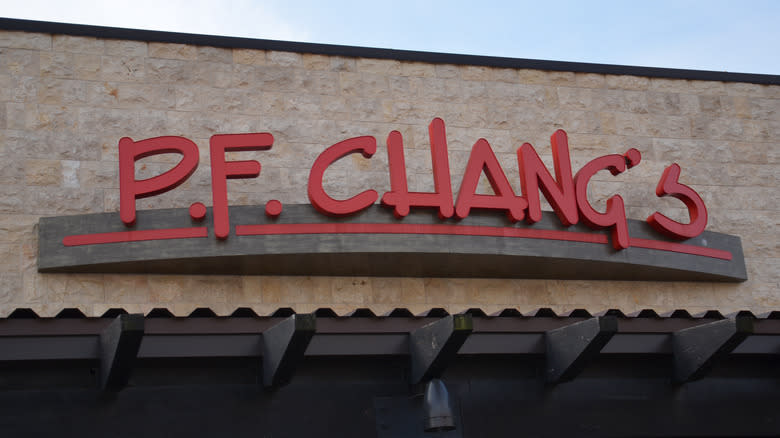
With the success of the Beverly Hills Mandarin, followed by The Mandarette Chinese Café, the Chiangs further cemented themselves as the face of authentic Chinese cuisine in California. The former earned a reputation for being a celebrity hot spot. Meanwhile, The Mandarette attracted a more casual audience by offering a menu composed of fine dining dishes (like those served at its upscale sibling) and simplified street-influenced Chinese food. It was affordably priced and an aesthetic far cry from the fanciful Mandarin brand.
Philip and Flemings' budding friendship inspired P.F. Chang's name. The "P.F." stands for Paul Fleming and the "Chang's" represents Philip Chiang. Scottsdale Mall in Arizona had the honor of housing the first location, attracting 1,000 customers in the first weekend alone. Philip brought a simplified approach to Chinese cuisine, and Fleming elevated the experience with an American-style service, wine list, and dessert menu.
Phillip Chiang's Mother Introduced Chinese Cuisine To America
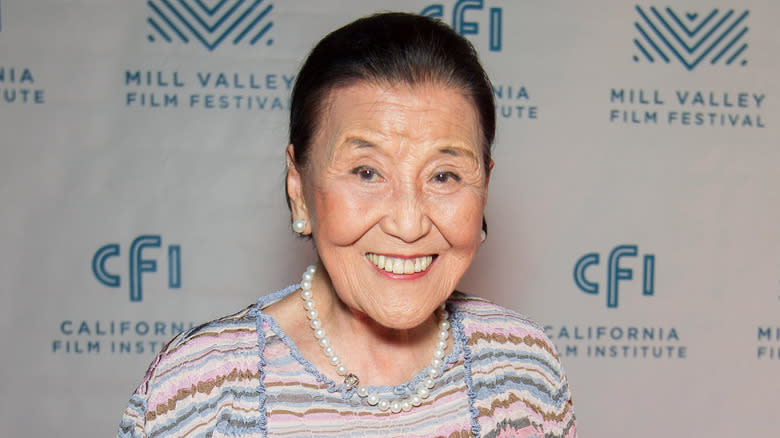
P.F. Chang's follows in the footsteps of culinary pioneer Cecilia Chiang, who some call "the Julia Child of Chinese cooking." Cecilia's story began long before arriving in San Francisco in 1959. Growing up in a wealthy household with two cooks and a rule that the kitchen was off-limits, she developed a love for authentic Chinese food, though not any cooking skills. In 1937, the conflict between Japan and China intensified, ending her cushy lifestyle. Chiang was able to flee years later, weathering a 1,000-mile journey to Chongqing. There she'd meet her husband and have two children, serve as a Chinese spy during the war, and successfully escape from China to Japan.
Finally able to pursue her dream of opening a restaurant, her first foray came to an unexpected halt after visiting San Francisco in 1959. While navigating Chinatown's Americanized food scene, Chiang was asked by two Chinese women she'd known if she'd invest in a restaurant. She did, and they ultimately backed out. Chiang opened The Mandarin, introducing iconic dishes like potstickers, hot-and-sour soup, tea-smoked duck, and other Chinese foods you need to try at least once. By 1968, The Mandarin attracted celebrities like Tony Bennett, John Lennon, Yoko Ono, and Elton John. A second location in Beverly Hills and The Mandarette Chinese Café were opened later. Those achievements only scratch the surface of Chiang's contributions, a force who remained pivotal to Chinese cuisine until she was 100 years old.
Lettuce Wraps Are Popular In America Because Of P.F. Chang's

If you're a fan of P.F. Chang's, odds are you've tried their iconic lettuce wraps. They are one of several food concepts taken from The Mandarin, where squab (or pigeon) was used in place of today's world-famous chicken iteration. Chicken lettuce wraps have been a popular menu item since P.F. Chang's opened in 1993. Even today, they are considered the number-one favorite among fans of the franchise. The description on the website cheekily offers, "A secret family recipe and our signature dish. Enough said."
Chiang has never shared the actual recipe, which hasn't prevented passionate attempts at recreating the mouthwatering magic. At the very least, we know that the ingredients include minced chicken, garlic, scallion, sesame oil, iceberg lettuce, and crispy rice sticks. Having the parts is one thing, knowing how to make a sturdy and hearty lettuce wrap is another. The recipe remains a secret after nearly three decades of lettuce wrap fandom. (P.F. Chang's recently pulled an April Fools joke on customers that involved Cheeto-topped lettuce wraps, announcing plans to change the iconic recipe.)
Chinese Is One Of Several Asian Cuisines On The Menu

Growing up in Japan played a significant role in shaping Philip Chiang's perspective. It inspired how he approached P.F. Chang's, which is to keep the food simple and balanced. Though he chose a Japanese approach, he kept the menu mostly Chinese. It gradually evolved over the years to include not only Japanese, but Korean, Thai, and other influences. Chinese cuisine still makes up the majority, but as the restaurant's website underscores, "From the very beginning, our menu has been inspired by the great street food cities across Asia."
The menu still features the influence of Philip's mother though. Besides the aforementioned lettuce wraps, he uses her original spicy chicken recipe and maintains that it hasn't changed since the restaurant opened. You'll find Chinese cuisine classics like dim sum and lo mein, Japanese cuisine favorites like sushi and mapo tofu, along with popular Southeast Asian dishes like pad thai and Singapore street noodles, among many menu items.
The Food Is Made From Scratch Each Day
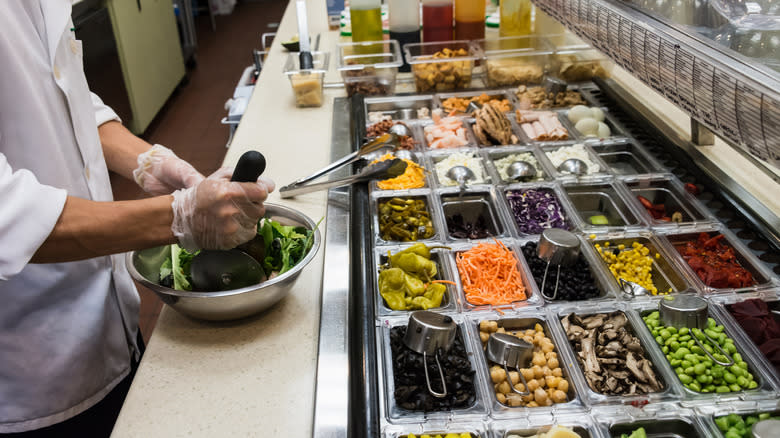
P.F. Chang's holds the honor of being America's first multi-unit restaurant concept to observe China's tradition of wok cooking, which goes back 2,000 years. He's a huge proponent of making food from scratch. "We're not like other 'chain' restaurants," the website emphasizes. Everything at P.F. Chang's is made fresh daily and has been since day one. Former and current employees have verified the claim, with many expressing a fondness for the work environment. Desserts are the only exception that popped up.
Gluten-free, vegetarian, plant-based, and every diet in between can find something to enjoy at P.F. Chang's. The made-from-scratch approach allows customers to customize menu items to their liking. There is even a dedicated allergen menu that breaks down which ingredients are compatible with specific dietary lifestyles, though for those living with allergies, the restaurant says it's best to call ahead about any necessary special accommodations.
Wok-Style Is The Cooking Method Of Choice
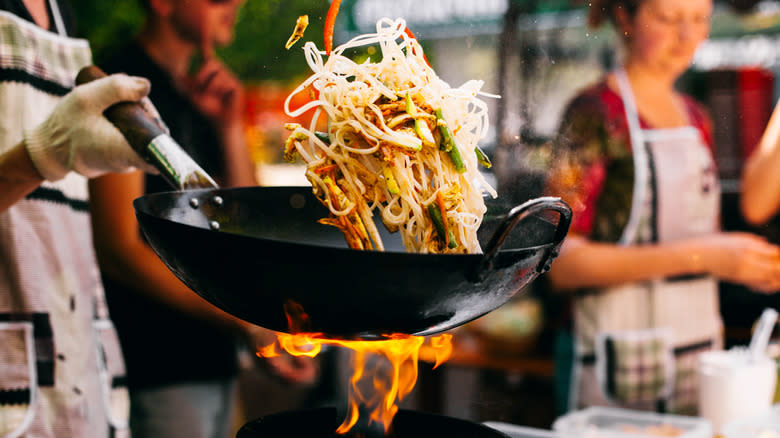
At P.F. Chang's, the guests are invited to experience cooking with a wok. Simple yet versatile, it not only adds to the restaurant's authenticity, it gives dishes a signature flavor that's unique to the franchise. The charred smokiness that emits from wok-cooked food comes from wok hei. In English, it literally translates to "breath of a wok." Chinese people have cooked with woks for thousands of years because they can be used for stir-frying, braising, boiling, poaching, stewing, and with a lid, steaming as well.
A bowl-like shape is one of the wok's key characteristics; the roundness helps the heat distribute evenly and cook more efficiently. P.F. Chang's also doesn't require new prep and line cooks to have experience, offering paid training on the job. Described as "a culinary symphony highlighted with pyrotechnics," wok cooking is one of the most exciting parts of dining at P.F. Chang's.
There Are Hundreds Of P.F. Chang's Locations Worldwide
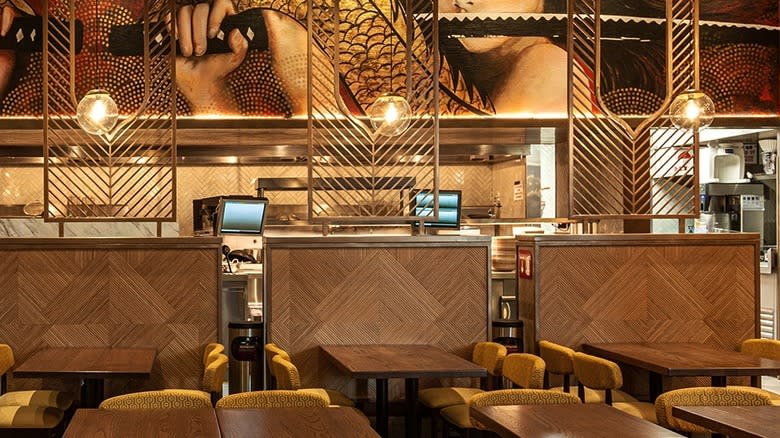
What does it take to become the most successful Asian cuisine-focused restaurant brand in the world? According to Philip Chiang, P.F. Chang's was never intended to be a chain, let alone a globally recognized one. He and co-founder Paul Fleming sort of just went with the flow and 31 years later, own more than 300 locations nationwide and abroad. Some of the countries include South Korea, the Philippines, Mexico, Canada, and the United Kingdom.
P.F. Chang's kicked off its international expansion in 2009, opening locations in Mexico City and Kuwait. Its arrival is often welcomed by a surprising familiarity with the brand. Chiang recalls how the brand recognition made expanding to the Middle East fairly easy. The famed restaurant is also a bucket list hot spot for tourists visiting the U.S. Global footprint aside, P.F. Chang's expansion remains on the fast track, with plans to open additional locations in Guyana, Salt Lake City International Airport, and more.
It Took 25 Years To Open Its First Location In China
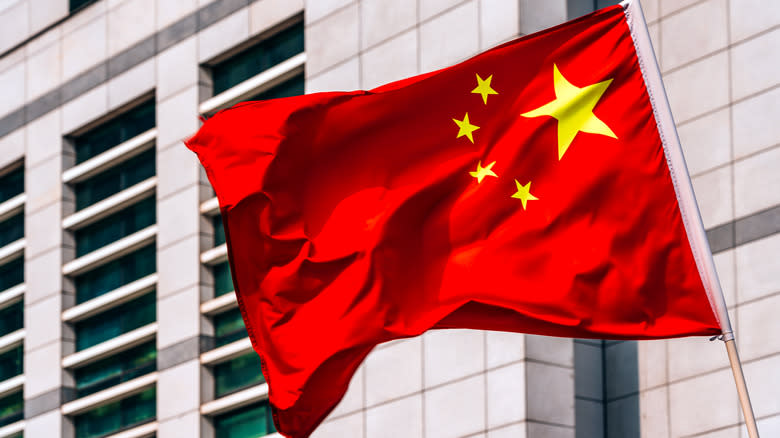
P.F. Chang's road to global dominance wasn't all paved in gold. The country primarily responsible for inspiring the brand was one of the last to have a location. What took the company most integral to introducing Chinese cuisine to a global audience so long to open a restaurant in Shanghai? Well, according to Philip Chiang, the Chinese market presented unique challenges. For one, China has a regional cuisine specifically geared towards locals, whereas P.F. Chang's offers flavors from throughout Asia.
Another obstacle it had to overcome was the service style. P.F. Chang's Western approach, which focuses on individual meals, is in stark contrast to China's communal style of service. Those were the hurdles in 2015, but by 2018, the company successfully made the leap. There was one blaring caveat, though: It was forced to drop "China Bistro" from the name in place of "An American Bistro." It's ironic because Americans go to P.F. Chang's for Chinese food, yet the menu is viewed as American-inspired in China.
It Gave Sriracha Sauce A Significant Boost
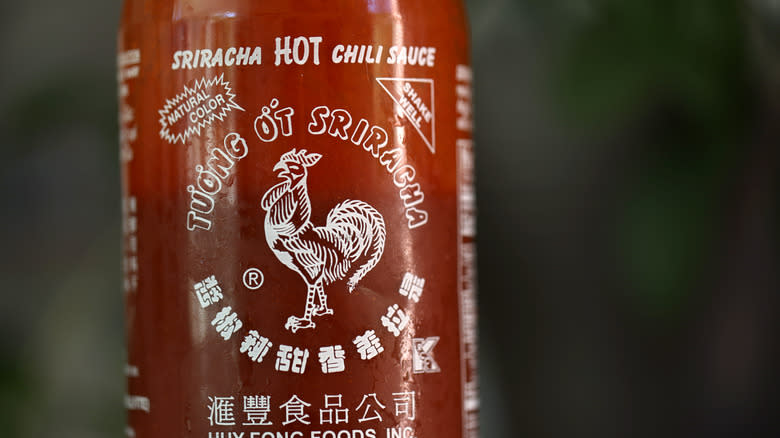
Trailblazing seems natural for P.F. Chang's. If its list of accomplishments wasn't already impressive, wait until you hear about the significant role it played in increasing sriracha's popularity. It was the first national chain to choose sriracha as one of the main condiments. The piquant sauce was officially added to locations in 2000 and now P.F. Chang's uses more than 100,000 bottles per year. Clearly, customers can't get enough of its garlicky kick.
Since being introduced, the restaurant has found other inventive, and delicious, ways to incorporate the sriracha flavor. On the menu, you'll find tempura-battered shrimp with sriracha aioli and a tempura-battered shrimp California roll with sriracha aioli and umami sauce. P.F. Chang's also makes a versatile Sriracha Mayo Dynamite Hot Sauce that'll spice up home-cooked meals. Those aren't the only ways P.F. Chang's honors the sriracha name, the love even extends to its frozen line, which features chili sriracha cream cheese wontons.
It Was A Pioneer In Offering Gluten-Free Options
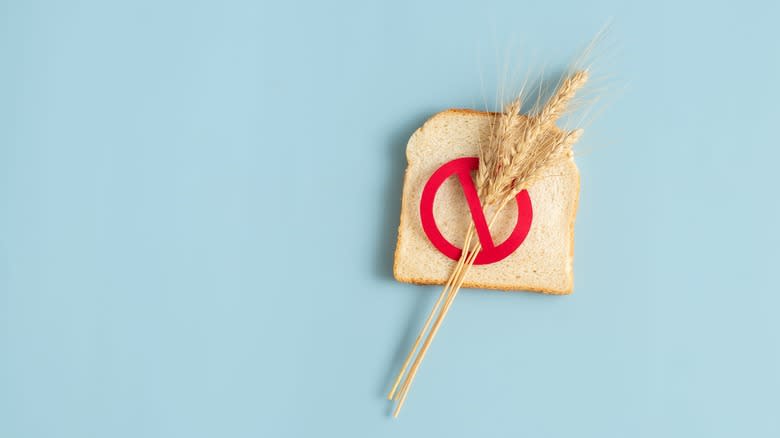
The made-from-scratch approach plays a big part in P.F. Chang's success. Along with freshly cooked food, customers can order according to their individual allergies and dietary needs. The allergen matrix breaks down each ingredient used in each menu section. Simply put, if gluten is bad for you, P.F. Chang's provides a transparent map of what menu items to avoid. You can also check on the website beforehand.
Speaking of gluten-free, P.F. Chang's pulled off another pioneering move when it launched a dedicated menu over 20 years ago. The menu features 15 items to choose from, from appetizers to mains and desserts. Having a fully customizable menu is presumably important for a global brand with hundreds of customers with varying dietary lifestyles. It's earned the restaurant a reputation for being a safe dining option for those who live with celiac, an autoimmune disease that makes people sensitive to foods with gluten and can harm the small intestines.
Millions Of Fortune Cookies Are Given Out Each Year
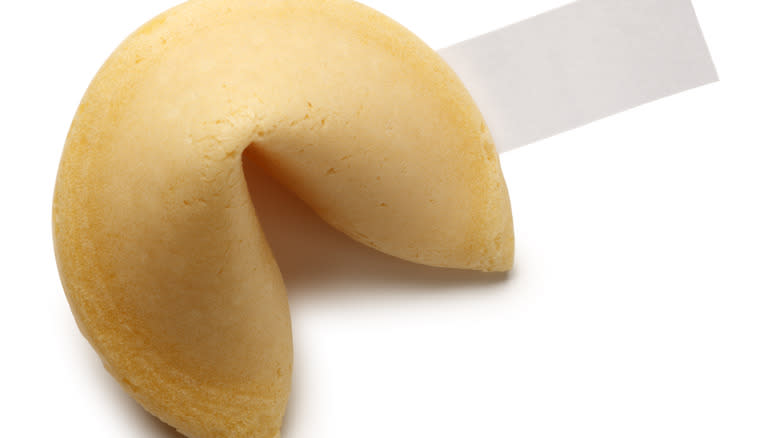
In America, fortune cookies are an indelible part of dining at a Chinese restaurant. Those positive paper affirmations don't always make sense, but they're tasty and add an endearing quality to the experience. If you're looking to up your good fortune, P.F. Chang's gifts the world with 52 million cookies each year. Thanks to the tiresome work there, you don't have to worry yourself with how fortune cookies are made.
Although we've come to associate them with Chinese cuisine, funny enough, fortune cookies are more likely to have been a Japanese invention. There's a lot to the story, but here's a super truncated version. After Pearl Harbor was attacked, businesses owned by Japanese immigrants in America were forcibly shuttered, and Chinese American manufacturers saw it as an opportunity to get in on the fortune cookie game. Most people think of China when it comes to fortune cookies today because of the role they played in producing them.
It Spawned A Spinoff Named Pei Wei Asian Kitchen

The massive success of P.F. Chang's gave birth to a fast-casual restaurant named Pei Wei Asian Kitchen. Unlike the casual setting at P.F. Chang's, customers got the best of both worlds: a sit-down experience with convenient fast food service. The menu was pared down and the portions were smaller, but the company was able to offer some of its hits at a lower price point. The first location was also opened in Scottsdale, Arizona in 2000, which may have been an ode to its parent company.
At its inception, and even now, much of Pei Wei's menu consisted of P.F. Chang staples. The menu still features its signature chicken lettuce wraps, even though the two brands split in 2017. Pei Wei was yet another notch on P.F. Chang's success belt, as today there are almost 200 nationwide locations, with many more planned.
Skip The Restaurant And Try P.F. Chang's Frozen Meals
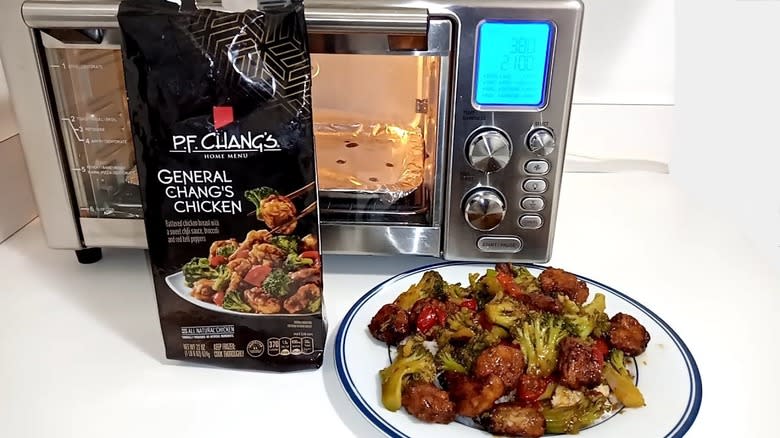
Fans were given the chance to take the P.F. Chang's experience home when the brand entered the frozen section in 2010. Appropriately named P.F. Chang's Home Menu, the initial line included premium entrées like orange chicken, Shanghai-style beef, sweet and sour chicken, and more. The frozen foray came from a partnership with Unilever North America, a major consumer goods company that owns several popular food and hygiene brands. Two years later, it was acquired by another major consumer goods company named ConAgra.
Since its release, the line has expanded beyond entrees to include single-serve meals, seafood, snacks and appetizers, sides, sauces, and dressings. The best part is that most of the frozen meals take less than 10 minutes to whip up. You'll miss out on the immersive Asian-centric decor, but still get to enjoy the signature P.F. Chang's taste.
Popular TV Shows Frequently Reference It

Entertainment caught the P.F. Chang's bug too. The brand was featured in not one, but two episodes of the popular comedic sitcom "Big Bang Theory." It was first referenced in the 14th episode of season 3, then in the follow-up episode as a gifting option for a romantic interest. There's a surprising backstory. According to Brands And Films, it wasn't an official product placement. P.F. Chang's happened to cater for the show and the crew simply offered to mention them. The episode went on to garner 16 million viewers.
Deadpan comedy "The Office" also referenced the chain in a season 6 episode called "Secretary's Day." Michael Scott shares his excitement over an upcoming trip to the Poconos where a P.F. Chang's is located, which is nearly an hour away from the show's setting of Scranton, PA. Shows like "The Simpsons," "American Dad!," and "Never Have I Ever" have also shouted out the famed establishment.
Static Media owns and operates Tasting Table and Mashed.
Read the original article on Tasting Table


